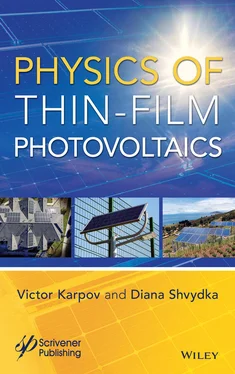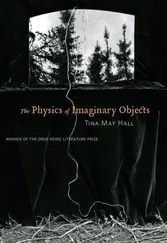Taken together, the latter subjects form the physics of thin film PV as a distinctive field of its own. This book will for the first time provide a consistent presentation of that field. In other words, this book will not describe the material of classical PV science, which has been masterfully described in other PV books, but will instead introduce material that has never been presented in PV books before.
To better explain our book title, we would like to emphasize the term of physics as defining the filed that is not necessarily related to the object’s materials, chemistry or engineering. The physics was always related to phenomena per se, regardless of the material specificity. Think, for example, of the Newton’s second law where the material structure does not matter, think about the fact that the Planck’s constant and Boltzmann’s constant do not depend on which material they describe, and how, in the physics of disordered systems, it does not matter what is the chemical composition of a system, etc. Similarly, in the photovoltaic science, the basics (built-in field, junction, and so on) remain material unspecific. Along these lines, our book concentrates on the aspects that are not sensitive to the material structure or composition. That is not to denigrate the known great contributions to photovoltaics from the materials sciences and chemistry, which appear dominant from any query of recent publications, but rather to preface our book limitations.
In our experience, the concept of a distinctive field of thin film PV physics may not appear obvious to everybody: quite a few in the community believe that thin film PV must be understood in the framework of classical PV science developed earlier and proven for thick crystalline systems. Such a resistance appears rather paradoxical given that thin film PV is made of materials that seem unacceptable from the classical PV perspective, and yet they often outperform classical PV. Our book solves that paradox by switching to a new physics paradigm.
The book is naturally broken into six parts, each containing several interrelated sections.
Part I, consisting of just section I, gives a general introduction to PV including the concepts of junctions, material requirements, and distinctive features of thin film PV.
Part II, encompassing sections II to V, concentrates on one-dimensional concepts relevant to thin film PV. It presents a densely populated zoo of various diodes, some quite different from p-n junctions, including the ones that play a significant role in thin film PV operations. It then extends that diode consideration on one-dimensional analysis of solar cells, including some important case studies.
Part III, made up of sections VI to XIII, takes the consideration beyond one-dimensional physics considering lateral effects, such as shunting, random micro-diodes, weak diodes, etc., addressing both the related theory and observations.
Part IV, including sections XIVto XVIII, concentrates on electronic processes in disordered materials of thin film PV which addresses morphology, fluctuations, transport properties, recombination in the quasi-continuous spectrum of localized states, operations of nonocrystalline junctions, and, finally, piezo photovoltaics.
Part V, formed by sections XIXto XXIV, presents the subject of electro-thermal instabilities in thin film PV starting from the exactly solved two-diode model and current hogging to spontaneously formed hot spots conducive of performance degradation.
Part VIincludes sections XXV to XXVIIIand discusses a sensitive issue of device degradation for thin film PV, including both solar cells and PV modules. It then discusses the problematic of accelerated life testing and risk analyses.
Finally, our book has an Appendix that comprise three parts of methodical value” the validity of in-series representation of complex band diagrams, the nature of saturation current in diode models, and accurate estimates for the electron potential fluctuations.
We are grateful to many people who have helped us to learn the subjects presented in this book. Our exposure to PV science and industry started with First Solar LLC (Perrysburg, OH) before the year 2000, at which time its research and production groups combined many enthusiastic contributors including H. McMaster, G. Dorer, G. Nelson, R. C. Powell, D. Rose, U. Jayamaha, E. Bykov, T. Maxon, R. Harju, T. Colman, L. McFaul, N. Reiter, T. Kahle, G. Khouri, G. Rich, M. Steel, and many others, to all of whom we are grateful for their intelligent friendly support. We would like as well to acknowledge our interactions with the PV group of the University of Toledo including A.D. Compaan, X. Deng, A. Vijh, D. Giolando, A. Vasko, Y. Roussillon, V. Parikh, L. Attigalle (Cooray), M. Mitra, M. Nardone, X. Li, V. Plotnikov, K. Wieland, and J. Drayton. Finally, we would like to express our gratitude to the members of CdTe PV National Team at NREL, starting with their remarkable managers K. Zweibel, B. von Roedern, H. Ulllal, and brilliant contributors B. McCandless, D. Albin, V. Kaydanov, T. Ohno, J. Sites, T. Sampath, A. Fahrenbruch, and so many others.
This book is intended for three readership categories. One is that of graduate and advanced undergraduate students with some understanding of the general physics and familiarity with the basic concepts of condensed matter. We hope that our book will bring to them a flavor of live physics in an informal manner as used by practicing researchers. It may help to open their eyes to a more general fact that the science of physics often evolves in its own ways quite different from those implied by the standard curriculum textbooks, and, for some, to become an evidence that physics can be relevant for PV.
Our next category of readers belongs to those in academic teaching and research revolving around semiconductors, device physics, and thin film structures. For that category, we aim to provide a fresh look at a number of subjects so established that they appear “carved in stone” for ages as dictated by the classical photovoltaic science developed during the times when thin film technology PV did not exist. Our book will invite that category of readers to pay more attention to the issues of variability and statistics apparent to those working for industry rather than for academia. Finally, we hope that some of our book topics and approaches can become a part of university curricula for PV/device physics or related disciplines.
We identify our third category of readers as the industrial R&D professionals of all levels. Their business responsibilities and hectic environment do not often leave much time to follow the published research and appreciate new concepts. We believe that our book will help the curious readers of that category to broaden their horizons and open new approaches towards technology goals. On top of that, adopting some concepts of our book could create beneficial synergy between physics and solar technology.
Victor Karpov Diana ShvydkaSylvania, Ohio, USA February 2021
Part I
General and Thin Film PV
I. Introduction to Thin Film PV
A number of brilliant texts are readily available describing the general photovoltaic (PV) principles and their classical implementations [1–6], as well as various specifics of thin film PV [7–11], and we are not going to duplicate them in any form. This section will briefly overview main book concepts especially addressing the underlying physics of PV functionality different between the crystalline and thin film devices. Such a synthetic view will help to inter-relate various sides of the physics of thin film PV as a subject of its own.
A. The Origin of PV. Junctions
We recall that PV effect in general is presented by the light generated voltage. The PV voltage when the system absorbed light creates electric asymmetry in the form of spatially separated opposite electric charges, electrons and holes, which can be extracted and utilized in the form of electric current. For the charge separation to occur, there must be a built-in electric field as illustrated in Fig. 1presenting a basic design of PV devices made of two semiconductor layers. The built-in field originates from the junction formed by those layers. Historically, such junctions were between p- and n-types of semiconductor layers; hence, the name of p-n junctions traditionally associated with PV devices. However, p-n junctions are neither necessary nor sufficient elements of systems with built-in fields as discussed below. For example, semiconductor/metal junctions in Fig. 1will generate their own built-in fields that can be either beneficial or detrimental to PV device functionality.
Читать дальше












